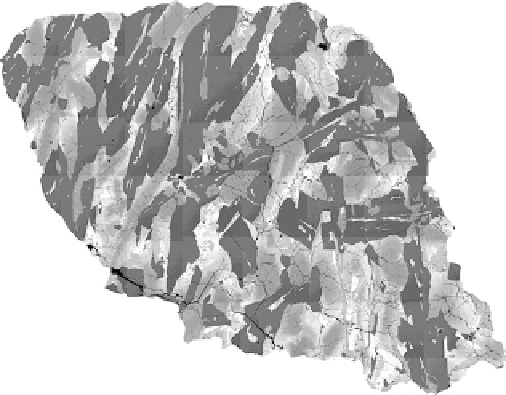Geology Reference
In-Depth Information
Figure 7.7.
Secondary electron image of elongated forms in
ALH 84001 cited as evidence for microfossils. Large image is 6
μm across, and higher resolution image is ~900 nm across.
Figure 7.8.
Backscatter electron map of QUE 94201, showing
zoned pyroxenes (light gray) and maskelynite (dark). Image is
1.3 cm across.
organic molecules to carry out metabolic and genetic
functions [
Morowitz
, 1996].
All of the cited evidence occurs associated with the
carbonate globules, so their environment (especially
temperature) of formation is critical to the argument
for life. The globules are chemically zoned, with cal-
cite-ankerite cores and magnesite-siderite rims. Based
on oxygen isotopes,
Romanek et al.
[1994] suggested
that the carbonate formed by reaction with aqueous
fluid at low temperature.
Harvey and McSween
[1996]
noted that the absence of phyllosilicates in ALH 84001
was inconsistent with hydrothermal reactions and
favored formation at high temperature. Subsequent
stable isotope [
Valley et al.
, 1997;
Leshin
, 1998;
Eiler
et al.
, 2002] and paleomagnetic [
Kirschvink et al.
, 1997]
measurements have established a low-temperature
origin, either by precipitation from hydrothermal
fluids [
Valley et al.
, 1997;
Treiman et al.
, 2002] or evap-
oration of brines [
McSween and Harvey
, 1998;
Warren
,
1998]. Following the precipitation of carbonates, likely
during multiple events [
Eiler et al.
, 2002;
Corrigan and
Harvey
, 2004], they experienced thermal decomposi-
tion and sometimes melting by shock [
Scott et al.
,
1997;
Golden et al.
, 2001].
Abiotic explanations for all the purported evidence for
life in ALH 84001 are now well established and accepted,
and the argument has mostly subsided. However, the
proposal of
McKay et al.
[1996] was influential in fueling
a vigorous, international Mars exploration program
focused on the search for water and life, and the efforts to
assess the purported evidence in this meteorite greatly
increased our understanding of the environmental con-
straints on living organisms and of the methods necessary
to explore for extraterrestrial life.
7.6. BASALTIC SHERGOTTITE: QUE 94201
Queen Alexandra Range 94201 was the first basaltic
shergottite added to the U.S. Antarctic collection
(excepting lithology B of EET A79001, which was not an
individual sample). Although small (12 g), its composi-
tion and properties identify it as an end member to the
basaltic shergottite suite, making it unique among this
group [
McSween et al.
, 1996;
Mikouchi et al.
, 1998]
(Plate 71). Pyroxenes are complexly zoned (sector zoned
in many cases) with cores of magnesian pigeonite man-
tled by magnesian augite, followed by rims of pigeonite
that extend to pyroxferroite (Figure 7.8). Other basaltic
shergottites are thought to have a two-stage cooling his-
tory, with cumulus magnesian pyroxene cores formed
at depth, and iron-rich rims formed during ascent or
eruption. In contrast, QUE 94201 pyroxene is thought to
have continuously crystallized without liquid removal or
assimilation, thus representing a liquid composition. This
interpretation is bolstered by crystal size distribution
(CSD) analysis of pyroxenes [
Lentz and McSween
, 2000]
and the high abundance of maskelynite relative to other
shergottites; plagioclase crystallization was late in most
shergottites but synchronous with pyroxene in QUE
94201. The melt was highly fractionated, producing iron-
rich minerals and a high proportion of phosphates.
The bulk composition of QUE 94201 was given by
Lodders
[1998]. It is depleted in incompatible trace
elements. Trace element patterns in minerals [
Wadhwa
et al.
, 1998] support continuous, closed-system fractional
crystallization of the magma. Crystallization occurred
under slightly more reducing conditions than for other
shergottites [
Herd et al.
, 2001;
Wadhwa
, 2001].


